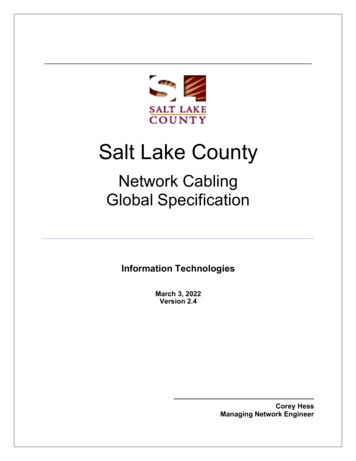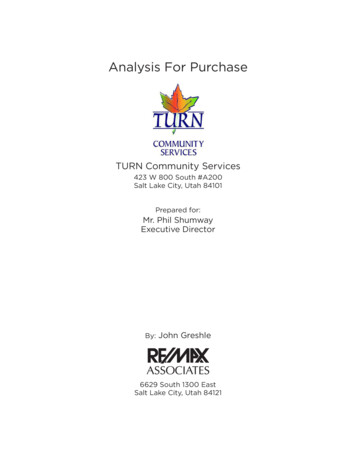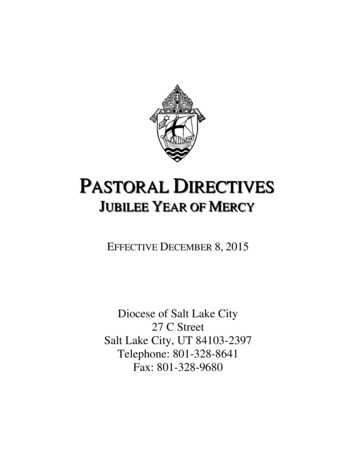
Transcription
Salt Lake CountyNetwork CablingGlobal SpecificationInformation TechnologiesMarch 3, 2022Version 2.4Corey HessManaging Network Engineer
Table of ContentsI. GENERALA. PurposeB. Scope of Work - TypicalC. Applicable Regulatory ReferencesD. Substitution PolicyE. Contractor QualificationsF. WarrantyII. Installation and Maintenance GuidelinesA. Maintenance of Patch FieldsB. Cable Pulling and TerminationIII. Cabling Systems and Associated InfrastructureA. Cabling Subsystem I – Horizontal Cabling SystemB. Cabling Subsystems II - Intrabuilding Backbone FiberC. Cabling Subsystems III - Interbuilding Backbone FiberD. Fiber ConnectivityE. Cable Pathways – Fiber & CopperF. 19” Racks and Rack-mount Cable ManagersG. Cable AccessoriesH. Communications Grounding NetworkIV. Network LabelingA. General RequirementsB. Labeling TermsC. Class of Facilities to be AdministeredD. Telecommunications Spaces (Rooms)E. Identifiers for Racks and CabinetsF. Multi-strand Fiber AssembliesG. Equipment Outlet LabelsH. Other Systems to Be LabeledV. Testing and AcceptanceA. GeneralB. Copper Link TestingC. Fiber TestingD. System DocumentationE. Test ResultsAppendix A – Materials 404142424343444446Page 2 of 57
I.GENERALA.Purpose1. The purpose of this document is to provide a standard defining the structured communicationscabling systems to be installed within, Salt Lake County facilities. It is geared toward leveragingour legacy cabling infrastructure while upgrading to more recent technologies in new installations.The goal is to accomplish this in the most economic and systematic fashion possible, and in amanner compliant with the latest codes, cabling standards and industry best practices.2. Within this document, the facilities owner is Salt Lake County, and shall be referred to as such, oras “Salt Lake County” or as “Information Technologies”. Bidding low-voltage installers shall bereferred to as “Contractor”.3.This specification defines quality standards and practices common to all Salt Lake Countyenterprise network cabling upgrades and Greenfield (new) projects.4. In addition to this global cabling standard, individual projects will also have associateddocumentation such as Requests for Proposals (RFP), facility drawings, project schedules andrequirements pertaining to that particular job. Such collateral will be referred to in this documentas “Project-Specific Documentation”, “Project Documentation”, or simply “ConstructionDocuments”. Any conflict between this general specification and any project-specificdocumentation shall be brought to the attention of Salt Lake County and must be resolved inwriting.5. It is the responsibility of the installing contractor to evaluate these general recommendations andadapt them effectively to actual projects. Contractor is responsible for identifying and bringing tothe attention of Salt Lake County any design directions that may be improved. All such changesshall be approved in writing from Information Technologies.6. Note that while many portions of this global specification are addressed to "The Contractor",these requirements apply equally to anyone doing the network cabling and infrastructure workwithin Salt Lake County, whether those persons are outside contractors or persons directlyemployed by Information Technologies.B.Scope of Work - Typical1. Contractor shall be solely responsible for all parts, labor, testing, documentation and all otherassociated processes and physical apparatus necessary to turn over the completed system fullywarranted and operational for acceptance by Salt Lake County.2. This specification includes structured cabling design considerations, product specifications andinstallation guidelines for low-voltage network systems and associated infrastructure including, butnot limited to:a.Cabling Sub-system 1 – Horizontal CopperPage 3 of 57
b.Cabling Sub-system 2 - Intrabuilding Fiber Backbone Cablingc.Cabling Sub-system 3 – Interbuilding Fiber Backbone Cablingd.Telecommunications Pathwayse.Communications Racks and Cable Managersf.Communications Grounding Systemsg.Cabling Labeling and Administration3. In addition to systems specifications, this document also addresses applicable codes andstandards, contractor qualifications and requirements, system warranties and system testing andacceptance.4. Products to be used in Salt Lake County telecommunications infrastructure projects are listed in“Appendix A” at the end of this document.C.Applicable Regulatory References1. Contractor is responsible for knowledge and application of current versions of all applicablestandards and codes. In cases where listed standards and codes have been updated, Contractorshall adhere to the most recent revisions, including all relevant changes or addenda at the time ofinstallation.2. ANSI/TIA:a.ANSI/TIA-526-7-A (July 2015) Measurement of Optical Power Loss of Installed Single-Mode Fiber Cable Plantb.TIA-526.2-A (July 2015) Effective Transmitter Output Power Coupled into Single-Mode Fiber Optic Cable - Adoptionof IEC 61280-1-1 ed. 2 Part 1-1: Test Procedures for General Communication Subsystems – Transmitter OutputOptical Power Measurement for Single-Mode Optical Fiber Cablec.ANSI/TIA-4994 (March 2015) Standard for Sustainable Information Communications Technologyd.ANSI/TIA-526-14-C (April 2015) Optical Power Loss Measurements of Installed Multimode Fiber Cable Plante.ANSI/TIA-568.0-E-2020 (March 2020) Generic Telecommunications Cabling for Customer Premisesf.ANSI/TIA-568.1-E-2020 (March 2020) Commercial Building Telecommunications Infrastructure Standardg.ANSI/TIA-568.2-D (September 2018) Balance Twisted Pair Communications and Components Standardsh.ANSI/TIA-569-D (April 2015) Telecommunications Pathways and Spacesi.ANSI/TIA-598-D (July 2014) Optical Fiber Cable Color Codingj.ANSI/TIA-570-C (August 2012) Residential Telecommunications Infrastructure Standardk.ANSI/TIA-606-C (June 2017) Administration Standard for Telecommunications Infrastructurel.ANSI/TIA-607-D (July 2019) Generic Telecommunications Bonding and Grounding (Earthing) for CustomerPremisesPage 4 of 57
m. ANSI/TIA-758-B (March 2012) Customer-Owned Outside Plant Telecommunication Infrastructure Standardn.ANSI/TIA-862-B (February 2016) Structured Cabling Infrastructure Standard for Intelligent Building Systemso.ANSI/TIA-942-B (July 2017) Telecommunications Infrastructure Standard for Data Centersp.ANSI/TIA-1005-A (May 2012) Telecommunications Infrastructure Standard for Industrial Premisesq.ANSI/TIA-1005-A-1 (January 2015) Telecommunications Infrastructure Standard for Industrial Premises, Addendum1- M12-8 X-Coding Connector - Addendum to TIA-1005-Ar.ANSI/TIA-1183 (August 2012) Measurement Methods and Test Fixtures for Balun-Less Measurements of BalancedComponents and Systemss.ANSI/TIA-1183-1 (January 2016) Measurement Methods and Test Fixtures for Balun-Less Measurements ofBalanced Components and Systems, Extending Frequency Capabilities to 2 GHz - Addendum to TIA-1183t.TIA-1152 (November 2016) Requirements for Field Test Instruments and Measurements for Balanced Twisted-PairCablingu.TIA-1179-A (September 2017) Healthcare Facility Telecommunications Infrastructure Standardv.ANSI/TIA-4966 (May 2014) Telecommunications Infrastructure Standard for Educational Facilitiesw.TIA-455-104-B (February 2016) FOTP 104- Fiber Optic Cable Cyclic Flexing Test (supersedes TIA-455-104-A)x.TIA/EIA-455-25-D (February 2016) FOTP-25 Impact Testing of Optical Fiber Cablesy.TIA-604-18 (November 2015) FOCIS 18 Fiber Optic Connector Intermateability Standard – Type MPO-16z.TIA-604-5-E (November 2015) FOCIS 5 Fiber Optic Connector Intermateability Standard- Type MPOaa. TIA-5017 (March 2016) Telecommunications Physical Network Security Standardbb. TIA-TSB-155-A (Reaffirmed 10-6-2014) Guidelines for the Assessment and Mitigation of Installed Category 6Cabling to Support 10GBASE-Tcc. TSB-184-A (March 2017) Guidelines for Supporting Power Delivery Over Balanced Twisted-Pair Cablingdd. TIA TSB-184-A-1 (February 2019) Guidelines for Supporting Power Delivery Over Balanced Twisted-Pair CablingAddendum 1- use of 28 AWG cords - Addendum to TSB-184-Aee. TSB-4979 (August 2013) Practical Considerations for Implementation of Multimode Launch Conditions in the Fieldff.TSB-190 (June 2011) Guidelines on Shared Pathways and Shared Sheathsgg. TIA-TSB-162-A (November 2013) Telecommunications Cabling Guidelines for Wireless Access Pointshh. TSB-5018 (July 2016) Structured Cabling Infrastructure Guidelines to support Distributed Antenna Systemsii.TIA-492AAAE (June 2016) Detail Specification for 50-µm Core Diameter/125-µm Cladding Diameter Class 1aGraded-Index Multimode Optical Fibers with Laser-Optimized Bandwidth Characteristics Specified for WavelengthDivision Multiplexingjj.TIA-492AAAB-A (November 2009) Detail specification for 50-µm core diameter/125-µm cladding diameter class Iagraded-index multimode optical fiberskk. TIA-455-243 (March 2010) FOTP-243 Polarization-mode Dispersion Measurement for Installed Single-mode OpticalFibers by Wavelength-scanning OTDR and States-of-Polarization AnalysisPage 5 of 57
ll.TSB-172-A (February 2013) Higher Data Rate Multimode Fiber Transmission Techniques3. ISO/IECa.ISO/IEC TR 11801-99-01 Information technology – Generic cabling for customer premises: Guidance for balancedcabling in support of at least 40 GBit/s data transmission: Parts 1 and 2a.ISO/IEC TR 29106 AMD 1 Information technology -- Generic cabling -- Introduction to the MICE environmentalclassificationb.ISO/IEC 14763-3 Ed 2.0 Information technology -- Implementation and operation of customer premises cabling -Part 3: Testing of optical fibre cablingc.ISO/IEC 24764 AMD 1 Information technology – Generic cabling for data centresd.ISO/IEC 11801 AMD 1 AMD 2 Information technology – Generic cabling for customer premisese.ISO/IEC 15018 AMD 1 Information technology – Generic cabling for homesf.ISO/IEC 24702 AMD 1 Information technology – Generic cabling – Industrial premisesg.ISO/IEC 14763-1 AMD 1 Information technology – Implementation and operation of customer premises cabling –Part 1: Administrationh.ISO/IEC 14763-2 Information technology – Implementation and operation of customer premises cabling – Part 2:Planning and installationi.ISO/IEC 14763-2-1 Information technology – Implementation and operation of customer premises cabling – Part 21: Planning and installation – Identifiers within administration systemsj.ISO/IEC TR 24704 Information technology – Customer premises cabling for wireless access pointsk.ISO/IEC TR 24750 Information technology – Assessment and mitigation of installed balanced cabling channels inorder to support 10GBASE-Tl.ISO/IEC TR 29125 IT Telecommunications cabling requirements for remote powering of terminal equipment4. BICSI – Building Industry Consultative Services International – Published Standardsa.ANSI/BICSI 001-2009, Information Transport Systems Design Standard for K-12 Educational Institutionsb.ANSI/BICSI 002-2014, Data Center Design and Implementation Best Practicesc.ANSI/BICSI-003-2014 Building Information Modeling (BIM) Practices for Information Technology Systemsd.BICSI 004-2012, Information Technology Division Systems Design and Implementation Best Practices forHealthcare Institutions and Facilitiese.ANSI/BICSI 005-2016, Electronic Safety and Security (ESS) System Design and Implementation Best Practicesf.BICSI 006-2015 Distributed Antenna System (DAS) Design and Implementation Best Practicesg.ANSI/NECA/BICSI 568-2006, Standard for Installing Commercial Building Telecommunications Cablingh.NECA/BICSI 607-2011, Standard for Telecommunications Bonding and Grounding Planning and InstallationMethods for Commercial Buildings5. BICSI – Building Industry Consultative Services International – ManualsPage 6 of 57
a.Telecommunications Distribution Methods Manual, 13th Editionb.Information Transport Systems Installation Methods Manual (ITSIMM), 6th Editionc.Outside Plant Design Reference Manual, 5th Editiond.BICSI's ICT Terminology Handbook, Version 1.0e.Telecommunications Project Management Manual (TPMM), 1st editionf.Telecommunications Project Management Reference Document (TPMRD), 2nd Editiong.BICSI's Special ICT Design Considerations, Version 1.0h.Essentials of Bonding and Grounding, Version 1.06. National Electric Codesa.National Electrical Safety Code (NESC) (IEEE C2-2012)b.NFPA 70-2016, National Electrical Code (NEC )c.ANSI/IEEE C2-207, National Electrical Safety Code d.National Electrical Code (NEC) (NFPA 70)e.NFPA 72 National Fire Alarm and Signaling Code7. ASHRAEa.ASHRAE Standard 90.4P, Energy Standard for Data Centers and Telecommunications Buildings8. OSHA Standards and Regulations – all applicable9. Local Codes and Standards – all applicable10. Anywhere cabling standards conflict with one another or with electrical or safety codes, Contractorshall defer to the NEC and any applicable local codes or ordinances, or default to the moststringent requirements listed by either.11. Knowledge and execution of applicable standards and codes is the sole responsibility of theContractor.12. Any violations of applicable standards or codes committed by the Contractor shall be remedied atthe Contractor’s expense.D.Substitution Policy1. This is a performance-based specification developed from the experience of the Salt Lake CountyIT Division in providing exceptional solutions for all our facilities and departments. As such,substitution of specified products or systems is not allowed.2. Contractor shall assume all costs for removal and replacement of any product installed inPage 7 of 57
substitution of those specified. Such costs shall include but not be limited to labor, materials as wellas any penalties, fees or costs incurred for late completion.E.Contractor Qualifications1. GeneralContractor shall meet the following requirements: NO EXCEPTIONS. If you do not understandany aspect of these specifications, call Corey Hess– Managing Network Engineer over ITInfrastructure For clarification.a.Contactor shall be a current Panduit ONE Partner, SILVER or above only, that has completed theStructured Cabling Deployment Training (Panduit Certified Installer). A copy of the corporate Panduitmanufacturer certification shall be included with all quotes.b.Contractor must have at least 5 years documented experience installing and testing structured cablingsystems of similar type and size.c.Contractor shall have offices and service personnel based with a fifty-mile radius of Salt Lake County andbe capable of same-day response to service calls.d.Contractor shall employ at least one BICSI Registered Communication Distribution Designer (RCDD) tosign-off on all designs offered, including stamping the design with their current BICSI/RCDD stamp.e.Contractor shall have the responsibility to obtain any of the necessary permits, licenses, and inspectionsrequired for the performance of data, voice, and fiber optic cable installations.f.Contractor shall employ at least one BICSI certified Installer technician supervising and on the project fulltime.g.At least 30 percent of the technicians on the job must have a current Panduit Certified Copper Technicianscertificate, or accepted substitute manufacturer, to install copper distribution systems.h.At least 30 percent of the technicians installing any Fiber Distribution Systems must have a currentPanduit Certified Fiber Technicians certificate, or accepted substitute manufacturer certificate, to installfiber distribution systemsi.The Telecommunications contractor must provide a project manager to serve as the single point of contactto manage the installation, speak for the contractor and provide the following functions:j. Initiate and coordinate tasks with the Salt Lake County Project Manager and others as specifiedby the project schedule. Provide day to day direction and-site supervision of Contractor personnel. Ensure conformance with all contract and warranty provisions. Participate in weekly site project meetings. This individual will remain project manager for the duration of the project. The contractor maychange Project Manager only with the written approval of Salt Lake County.Contractor Project manager must be manufacturer certified in the copper and fiber information transportsystems to be installed.Page 8 of 57
k.Contractor shall have a BICSI certified RCDD on-site to supervise final testing.2. Referencesa.Communications Contractor shall provide with bid, a list of three reference accounts where similar Data,Voice, Fiber Optic Cable, and related equipment installation work was performed within the last year(twelve-month period).b.Communications Contractor shall provide copies of valid current certifications required in section E.1 ofthis document.3. Termination of Servicesa.Salt Lake County reserves the right to terminate the Communication Contractor’s services if at any timethe Salt Lake County Engineer determines the Communication Contractor is not fulfilling theirresponsibilities as defined within this document.b.Contractor’s appearance and work ethics shall be of a professional manner; dress shall be commensuratewith work being performed.c.Dress displaying lewd or controversial innuendos will strictly be prohibited.d.Conduct on Salt Lake County property will be professional in nature.e.Any person in the Contractor’s employ working on a Salt Lake County project considered by Salt LakeCounty to be incompetent or disorderly, or for any other reason unsatisfactory or undesirable to theInformation Technologies, such person shall be removed from work on the Salt Lake County project.f.Upon termination, the Communications Contractor shall be restricted from the premises andcompensated for the percentage of work completed satisfactorily.4. Other Contractor Responsibilitiesa.Confirmation of Pathway and Cable Manager Sizing: Wherever cabling pathways or managers are installed, it is the Contractor’s responsibility to confirmpathway or manager sizing to represent no more than 30% fill according to manufacturer’s fill chartsbased on projected cable densities when racking systems and cabling pathways are fully populated. Pathways overfilled upon installation will not be accepted and shall be remedied at Contractorexpense.b.Contractor is responsible for the removal and disposal of all installation and construction debris createdin the process of the job. All work areas will be cleaned at the conclusion of the workday and no tools ormaterials shall be left in a manner as to pose a safety hazard.c.Contractor must remove all abandoned cable per Article 800 of the National Electrical Code and per TIAand BICSI standards, recycling these materials where possible. Removal of orphaned cable is mandatory.Contractors must consider this when placing bids.d.Contractor shall abide by the regulations set by local Salt Lake County Security Policy pertaining to accessand conduct while on Salt Lake County property.e.Contractor shall obey all posted speed limits and parking regulations at the Salt Lake County facilitieswhere the work is being performed.Page 9 of 57
f.Test cables upon receipt at Project site. Test optical fiber cable to determine the continuity of the strand end to end. Use optical loss test set.Test optical fiber cable while on reels. Use an optical time domain reflectometer to verify the cablelength and locate cable defects, splices, and connector, including the loss value of each. Retain testdata and include the record in maintenance data.Test each pair of UTP cable for open and short circuits.Required InspectionsThe contractor shall meet before start of work to go over the scope and all specs to clarify any concerns.The contractor shall have a mid-point inspection of the project, so the County may go over the project todetermine cable standards are being followed. No ceiling tiles shall be installed until inspections of cablinghave passed.The contractor shall have a final inspection County will provide a punch list if needed.F.Warranty1. Generala.Contractor shall provide a 25 year Panduit Certification PLUS System Warranty on all copper and fiberpermanent cabling links.b.It is understood the Certification PLUS Warranty is a system performance warranty guaranteeing for 25years from acceptance that the installed system shall support all data link protocols for which thatCategory of copper cabling system or fiber OM/OS designation of fiber optic system is engineered tosupport according to current and future IEEE and TIA standards.c.The Certification PLUS System Warranty may be invoked only if the cabling channel links are comprisedof continuous Panduit, General and Belden Cable components, including patch cords, equipment cordsand fiber jumpers.d.Upon acceptance of Warranty, Panduit will mail a notification letter to the installer and a notification letterand warranty certificate to Salt Lake County.2. Contractor Warranty Obligationsa.Installation firm (Contractor) must be a current Panduit ONE Partner, SILVER or above, in good standingand shall include a copy of the company installation certification with the bid.b.Contractor shall name a supervisor to serve on site as a liaison responsible to inspect and assure allterminations are compliant to factory methods taught in Panduit Technician Certification Training, orapproved equal, and according to all Standards cited in the Regulatory References section of thisdocument.c.Contractor liaison (project supervisor) shall have a current, up-to-date Panduit Certified Technician (PCT)certificate in both copper and fiber. Copies of the copper and fiber certificates of the Panduit liaison shallbe submitted with the bid.d.Fiber optic cabling system additions and upgrade to existing facilities (Brownfield) shall match the fibertype (OM/OS designation) of the system to which it is being installed. Contractor shall under nocircumstances mix different OM/OS classes of cable or termination devices (connectors) within the samePage 10 of 57
system.e.All intrabuilding new fiber optic installations shall utilize an appropriate construction of OM3/OM4 orOS1/OS2 fiber as specified herein.f.All UTP cable pulled and terminated shall be Category 6/6A cable and connectivity whether new or legacysystems.g.All UTP terminations within the Salt Lake County Greenfield (new) projects shall be terminated using theT568B pin-out (wire map). Legacy additions shall match the copper pin-out of the facility to which cablingis being added-to or upgraded.h.Contractor shall install all racking and support structures according to cited Standards in such fashion asto maintain both cited industry standards as well as manufacturer recommendations for uniform support,protection, and segregation of different cable types,i.Contractor is responsible for maintenance of maximum pulling tensions, minimum bend radius, andapproved termination methods as well as adhering to industry accepted practices of good workmanship.j.Contractor is responsible for understanding and submitting to Panduit all documents required prior toproject start to apply for the Panduit Certification PLUS warranty. These include but are not limited to theproject information form and SCS warranty agreement.k.Contractor is responsible for understanding and submitting to Panduit all documents required at projectend. These include, but are not limited to: completed warranty forms, passing test reports and drawingsof floor plans showing locations of links tested.l.Test results shall be delivered in the tester native format (not Excel) and represent the full test report,summaries shall not be accepted. Contact your Panduit representative for a current list of approvedtesters, test leads and latest operating systems.m. The Communications Contractor will correct any problems and malfunctions that are warranty-relatedissues without additional charge to Salt Lake County for the entire warranty period.n.The warranty period shall commence following the final acceptance of the project by Salt Lake Countyand written confirmation of Warranty from Panduit. END OF SECTION Page 11 of 57
II.A.Installation and Maintenance GuidelinesMaintenance of Patch Fields1. Any persons, whether with a Contractor or Salt Lake County, adding or moving copper or fiber opticpatch (equipment) cords shall do so in a neat, workmanlike fashion in keeping with the originalsystem cable management design concept and according to all industry best practices as outlinedin cabling standards and applicable BICSI publications referenced in this document.2.B.Persons performing such moves, adds or changes (MACs) shall further adhere to the following:a.Use existing cabling management pathways and take care to place cable like with like, maintaining originalsegregation strategies for separating fiber and copper cables as well as any separation necessary betweendifferent types of copper cables.b.Cables shall be dressed neatly within patch management pathways with care taken to maintain minimumbend radius of not less than 1 times the cord outer diameter for copper and not less than a 1" bend radiusfor fiber jumpers as per ANSI/TIA 568-C.0.c.All patch cords used shall be of same Copper Category or Fiber OM/OS designation as the media usedin the permanent cabling links.d.Patching in all cases shall be done using factory terminated cords manufactured for that purpose. Handterminated patch cords will not be accepted.e.All patch cords or jumpers must be completely contained within supplied cable management paths.Cables draped across the front cabinets or racks will not be accepted and shall be remedied atContractor’s expense.f.Any persons installing or moving fiber optic patch cords for any reason will clean the connector with lintfree wipes and 99% or higher isopropyl alcohol before replacing the connector in a patch or equipmentport.g.Any technicians, whether with Salt Lake County or Contractors performing moves, adds or changes withinpatch field will label additions to the system according to the labeling conventions in place at that facility.h.Any persons with Salt Lake County or installing Contractor performing moves, adds or changes withinpatch field will record the move according to record system in place at that facility.Cable Pulling and Termination1. Generala.Contractor is responsible for installing systems according to all applicable codes and the standards citedin this document.b.Contractor shall use grommets to protect the cable when passing through metal studs or any openingsthat can possibly cause damage to the cable. This includes grommets on ends of hard conduit whereused.Page 12 of 57
c.Do not deform the jacket of the cable. The jacket shall be continuous, free from pinholes, splits, blisters,burn holes or other imperfections.d.Install proper cable supports, spaced less than 5 feet apart, and within manufacturer’s requirements forfill ratio and load ratings.e.Leave a pull string to the end of each conduit run. Replace pull string if it was used for a cable pull.f.Note service loops may not touch the drop-ceiling assembly. Any portion of the communications cablingmaking contact with ceiling structures must be remedied at the Contractor expense.g.Label every cable within 12 in. of the ends with self-laminating wire wrap cable appropriate to that cablesize. Use a unique number for each cable segment as required by the project documentation and thelabeling section of this document.h.Dress the cables neatly with hook and loop cable ties in telecommunications rooms. Contractorresponsible for using plenum ties and appliances in air-return (plenum) spaces as required by the localAHJ (Authority Having Jurisdiction).i.Contractors installing cabling systems in Salt Lake County facilities shall install plenum rated cable in allinstances. Non-plenum cable is not allowed and shall be removed at Contractor’s expense.2. Coppera.When making additions to legacy systems, Contractor shall match the cabling configuration (pinout) ofthe existing systems. Legacy systems at Salt Lake County are in most cases T568B.b.Within all new (Greenfield) installations within Salt Lake County facilities, contactor shall use copperpinout T568B.c.All four pair Category 6/6A cable runs shall be kept to a maximum permanent link length of 83 meterswhen using a total 10 meters of 28 awg” small diameter” patch cords.d.Copper links that are 90 meters in permanent link, shall not exceed 6 meters (total) of patch cords whenusing 28 awg “small diameter” patch cords.e.Use low to moderate force when pulling cable. Maximum tensile load may not exceed 25’ lbs. maximumpulling force per 4 pair cable.f.No pathway, including conduits shall have greater than a 35% fill per manufacturer fill charts. Contractoris responsible for bringing to the attention of Salt Lake County project manager any insufficiently sizedconduit or cable pathways in project documentation.g.Keep Category 6/6A cables as far away from potential sources of EMI (electrical cables, transformers,light fixtures, etc.) as required in cited TIA Standards.h.All copper horizontal cabling shall have slack service loops no less than 1 feet at the work area (equipmentoutlet) and not less than 2 feet in the ceiling with 10 feet of slack loop in the telecommunications room.i.Slack at the work area may be stored in the ceiling or in the wall space. Service loops in thetelecommunications room may be wall mounted or contained in pathways or racking systems if done in aneat, workmanlike fashion.Page 13 of 57
j.Service loops shall be stored in such fashion as to not violate bend radius, slack touching the drop ceilingis not allowed and must be remedied at Contractor expense.k.Maintain the twists of the pairs all the way to the point of termination, or no more than 0.5" (one half inch)untwisted.l.All UTP patching shall be accomplished using Category 6/6A rated modular patch panels as indicatedelsewhere in this document.m. A
g. ANSI/TIA-568.2-D (September 2018) Balance Twisted Pair Communications and Components Standards h. ANSI/TIA-569-D (April 2015) Telecommunications Pathways and Spaces i. ANSI/TIA-598-D (July 2014) Optical Fiber Cable Color Coding . b. ANSI/BICSI 002-2014, Data Center Design and Implementation Best Practices c. ANSI/BICSI-003-2014 Building .











